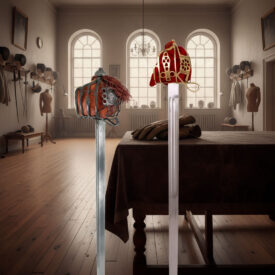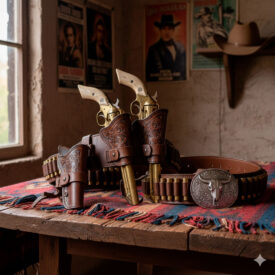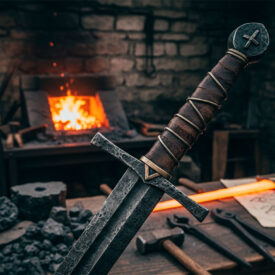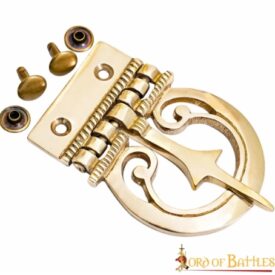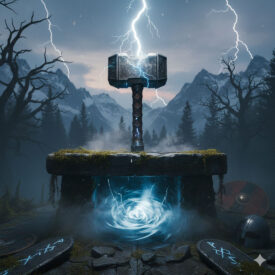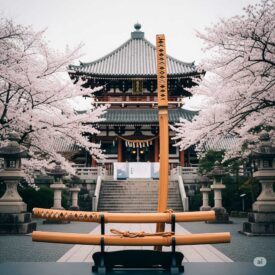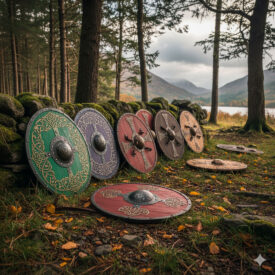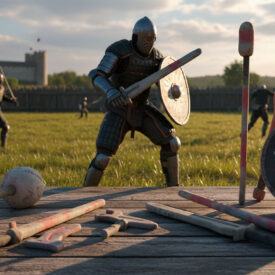What makes an Irish sword distinct from any other ancient blade? Imagine the clash of steel at dawn over an Atlantic cliff, the round pommel gleaming like a moon ring: that image summarizes the symbolic and functional strength of Irish swords, weapons that were at once tools of war, clan insignia, and ritual objects.
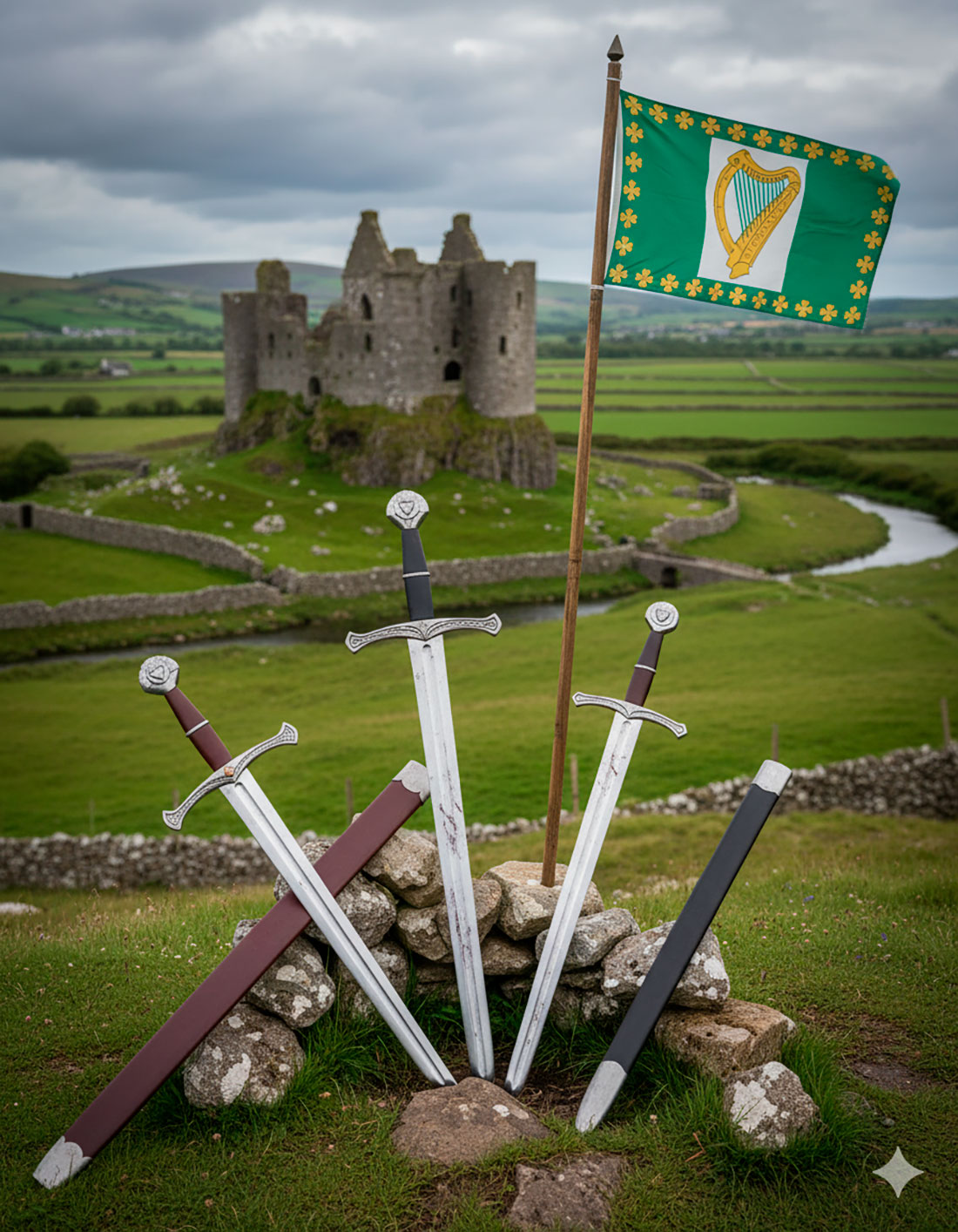
Why Irish Swords Matter Today
Irish swords appeal to historians, reenactors, and collectors because they condense centuries of cultural contacts — Celtic, Norse, and Scottish — and forging techniques that evolved from the Bronze Age to the Renaissance. Understanding their form is understanding the history of clans, mercenaries, and warfare in the British Isles.
Swords in Ireland: Historical Evolution and Notable Finds
Below is a chronological synthesis of sword types and the main archaeological and historical milestones related to weapons in Ireland, from the Bronze Age to modern documentation.
| Era/Date | Event / Sword Type |
|---|---|
| Bronze Age | |
| 1400 BC – 1000 BC | Presence of distinct Irish Bronze Age swords. |
| After 900 BC | Mass production of weapons, especially swords, and existence of secret chambers: indications of violence and insecurity (Late Bronze Age). |
| Iron Age and Celtic Culture | |
| 400 BC – 200 BC | Period associated with human sacrifices (e.g., Oldcroghan Man) in the pagan Celtic Iron Age. |
| 2nd Century BC | Celtic objects made in Ireland (such as decorated sword scabbards) show stylistic resemblance to continental European antecedents. |
| Around the time of Christ | Ironworking technology is fully assimilated in Ireland. |
| 1st Century AD | Celtic/Gaelic warriors in Ireland primarily use anthropomorphic and antennae-hilted iron swords, common designs in the Celtic world. |
| Christian Transition and Early Viking Raids | |
| 5th Century AD | Introduction of Christianity to Ireland, mainly through Roman Britain. |
| 795 AD | First recorded Viking raids begin in Ireland. |
| 9th and 10th Centuries AD | Viking trade activities bring silver to Ireland; manufacture of brooches and arm-rings in Viking settlements. |
| 9th Century AD | In Viking cemeteries of Kilmainham and Islandbridge (Dublin), warriors are buried with long swords — weapons superior to contemporary native Irish swords. |
| Mid-9th Century AD | Dating of the Ballinderry Viking Sword (Petersen Type ‘K’). Blade inscribed VLFBERHT; found in a crannóg, indicating high status. |
| 850 – 950 AD | Period of widespread diffusion of the Viking Type M sword in Norway; the Harley Park sword is the only certain example of Type M found in Ireland. |
| 928 AD | Record in the Annals of the Four Masters: Godfrey and the foreigners of Ath Cliath plundered Derc Ferna (Dunmore Caves). |
| Medieval Ireland and Development of Local Swords (c.1170–1600) | |
| 1150 – 1550 AD | Late Medieval Ireland period; emergence of a hybrid Anglo-Irish culture influencing weaponry and styles. |
| c. 1170 – 1600 AD | Chronological framework noted by Andrew Halpin for the development of medieval Irish swords. |
| 12th – 14th Centuries (Group 1) | Medieval Irish swords with British or continental styles. |
| Mid-13th Century AD | Arrival of the first Gallowglass mercenaries (from the Scottish Highlands) who begin to serve in Ireland. |
| 15th Century (Group 2) | Swords show a Scottish style: quillons curved forward (“proto-claymores”), presumably introduced by the galloglaich. |
| Early 16th Century AD | Appearance of the Irish type sword with distinctive ring pommel (Group 3). |
| 16th Century | Group 3 swords adopt more distinctive forms (ring pommels, flared cross-guards). Gallowglass commonly carry a shorter claymore and axe; evidence of continuous Hiberno-Scottish contacts. |
| Later Finds and Documentation | |
| 1832–1833 | George Petrie documents a dubious Type M (Viking) sword found in Bully’s Acre, Kilmainham. |
| 1928 | The original Ballinderry Viking sword is found. |
| 1945 (?) | Dr. William Phelan exhibits the Harley Park Viking sword at a meeting of the Kilkenny Archaeological Society (KAS). |
| 1951 | The Harley Park sword is deposited and registered at the National Museum of Ireland. |
| 1966 | The Harley Park Viking Sword is put on display at the Rothe House Museum. |
| 1986 | Publication by Andrew Halpin: “Medieval Irish Swords c. 1170–1600”, a key synthesis on the development of swords in Ireland. |
Origins and Cultural Mix: Celts, Vikings, and Scots
The islands hosted a melting pot of styles. Celtic peoples developed swords from the Iron Age; Vikings brought long blades and advanced casting; Scottish gallowglass introduced curved quillons and the short claymore. The result: Irish swords that often combined pragmatism and ornamentation, with pommels and guards that functioned as a regional signature.
The Ring Pommel: Form and Symbolism
The ring pommel that characterizes many Irish swords of the 15th–16th century is not just an ornament. It provides a solid anchor for the tang, allows for a distinct balance, and acts as an identifying element of lineage or workshop. It was both practical and symbolic.
Gallowglass: Mercenaries Who Changed the Face of Warfare
The Gallowglass (galloglaigh) were elite mercenaries from northwestern Scotland. They arrived in Ireland in the mid-13th century and their presence intensified until the 16th century. These physically powerful warriors introduced tactics, heavy weaponry, and sometimes two-handed swords with ring pommels that became emblems of military power.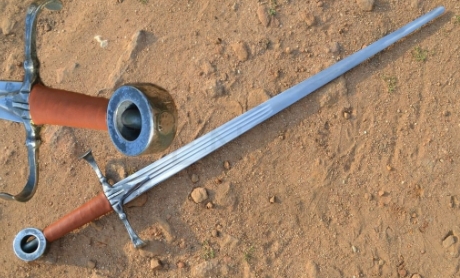
Designs: From One-Handed Sword to Irish Claymore
Irish swords adopted different configurations according to their use: more maneuverable one-handed swords for kerns, wider blades for gallowglass, and large two-handed swords for open domains. Variations did not only serve tactics but also the identity of the wielder.
Common Types and Names
-
Clan Sword: symbol of status and power within the clan; could be inherited generation to generation.
-
Kern Sword: light and maneuverable, for fast infantry and skirmishes.
-
Claymore/Gallowglass: larger swords, often two-handed or with a broad grip, used by heavy mercenaries.
Replicas and Variants: Historical and Practical Models
Today you can find replicas covering the entire spectrum: from ornamental pieces to functional swords for reenactment. Some replicas seek historical accuracy in materials and construction; others are designed for safe practice with blunt edges and balance intended for sparring.
How to Recognize a Faithful Replica
-
Blade material: carbon steel or tempered alloys are the closest to the original.
-
Pommel and hilt: a well-executed ring pommel and a riveted tang are signs of authenticity in design.
-
Scabbard and mounting: wood scabbards covered in leather with metal fittings respect tradition.
Forging and Historical Techniques
The techniques for manufacturing Irish swords combine forged steel, tempering, and, on occasion, pattern welding. Blacksmiths controlled the composition and microstructure by hot forging and tempering, seeking a tough core and a harder surface.
Simplified Forging Process
-
Initial forging: shaping the blade from forged bars or ingots.
-
Normalizing and tempering: controlled heating to balance hardness and toughness.
-
Finishing: sanding, polishing, and assembly of the hilt and pommel.
Use and Tactics: How They Were Employed in Combat
A sword is an extension of the warrior. One-handed Irish swords allowed for agile skirmishes; broad blades and claymores offered power in head-on clashes. Gallowglass, with their compact formation and heavy weaponry, changed the rhythm of engagements.
Tactical Examples
-
Light infantry: use the sword for quick cuts and withdrawal maneuvers.
-
Heavy formation: long swords and axes to break enemy ranks.
Practical Comparison: Choosing According to Use
| Type | Blade Length (approx.) | Recommended Use | Advantages |
|---|---|---|---|
| Kern Sword | 75–90 cm | Light reenactment and practice | Light and versatile for quick maneuvers |
| Ring Pommel Sword | 85–100 cm | Display, reenactment, and stage combat | Distinctive balance and historical value |
| Claymore/Gallowglass | 100–140 cm | Decoration, exhibition, and mercenary representation | Visual impact and stage presence |
Maintenance and Conservation
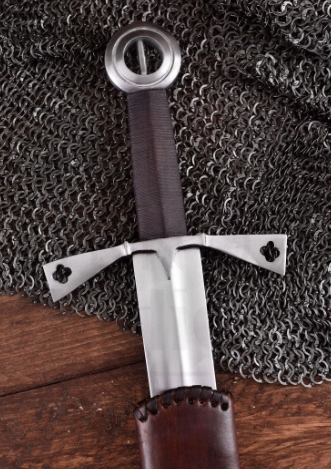 Proper sword maintenance involves controlling humidity, maintaining a protective layer on the blade, and storing in stable conditions. Adequate cleaning and oiling prevent corrosion and preserve the metal’s shine.
Proper sword maintenance involves controlling humidity, maintaining a protective layer on the blade, and storing in stable conditions. Adequate cleaning and oiling prevent corrosion and preserve the metal’s shine.
Recommended Products and Methods
-
Cleaning: microfiber cloth and isopropyl alcohol to remove dirt before oiling.
-
Oiling: apply a thin layer of mineral or camellia oil; avoid products containing acids.
-
Storage: avoid humid environments and use supports that do not pinch the scabbard.
Clearing Up Unknowns About Irish Swords
What is the difference between a clan sword and a basket-hilted sword?
The main difference between a clan sword and a basket-hilted sword lies in their guard design and function:
-
Clan Sword: This is a broad term that can refer to swords specific to a group or region, often with a traditional or cultural design, but generally does not have a specific guard type universally associated with that name.
-
Basket-hilted Sword: Characterized by having a basket-shaped guard, a metallic cage that protects the user’s hand during combat. This design provides greater hand protection compared to swords with simple or crossguards.
What forging techniques were used to make Irish swords?
Irish swords were primarily made with forged iron, using traditional forging techniques that included heating the metal red hot and then shaping it by hammer blows on an anvil. In some cases, a technique called pattern welding was applied, which consisted of joining and folding several layers of iron or steel to strengthen the blade, improve its resistance, and better distribute the carbon. This technique also created a visible pattern on the blade. Additionally, hilts were made from materials such as wood, bone, or metal, and scabbards were made of iron or bronze, often decorated with typical Celtic motifs.
Therefore, the key forging techniques in Irish swords included red-hot forging, hammer shaping, and in some cases pattern welding to improve steel quality and blade strength. Tempering processes were also applied to harden the surface while maintaining core flexibility.
How did the ring pommel originate in Irish swords?
The ring pommel on Irish swords originated in the medieval tradition, estimated to date back to the 13th century and becoming particularly popular in the 15th and 16th centuries. This pommel has an open circular shape through which the end of the blade’s tang is visible, which was typical in swords used by the kern or ceithern, Irish light infantry soldiers of the era. Many original examples with this design have been found throughout Ireland and are displayed in museums such as the National Museum of Ireland in Dublin and the Ulster Museum in Belfast. The characteristic ring pommel shape appears to have been both functional and symbolic within medieval and Renaissance Irish warrior culture.
What role did the Gallowglass play in the Irish wars?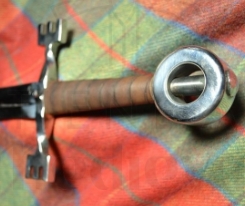
The Gallowglass were elite mercenary warriors, primarily of Norse-Gaelic origin from Scotland, who played a fundamental role in the Irish wars from the 13th to the 16th centuries. They served as a specialized and organized military force that supported Irish lords in their resistance against invasions, especially against the English. In exchange for their military services, they received land and settled in Ireland, where they integrated into the local nobility. Their presence strengthened the defense of Irish clans, being a decisive factor in containing Anglo-Norman expansion and participating in internal conflicts and against English forces. Over time, their army expanded with native Irish, and they remained a key component in traditional warfare before the definitive arrival of gunpowder and military change.
Where can replicas of Irish swords be seen on display?
Replicas and some originals of Irish swords can be seen on display at the National Museum of Archaeology in Dublin and the Ulster Museum in Belfast. These museums house examples of medieval Irish swords, such as those from Ulster with characteristic ring pommels, and also 16th-century swords related to the gallowglass, elite Irish mercenaries.
| Oil Type | Main Characteristics | Recommended Use |
|---|---|---|
| Mineral oil | High penetration, does not degrade or attract dirt | Regular protection and maintenance |
| Camellia oil | Natural, acid-free, non-volatile | Antioxidant protection, lubrication |
| Lithium grease | Dense, durable, does not evaporate | Long-term storage, protection |
Practical Chronology for Collectors and Reenactors
If you collect or reenact, having a mental chronology helps choose the correct model for your project: from Bronze Age swords for early settings to ring pommels for late Medieval and Renaissance scenes. The above chronology will serve as a guide for matching sword, attire, and historical context.
Tips for Integrating an Irish Sword into Your Reenactment
-
Choose the sword type according to its function: stage combat, display, or training.
-
Pay attention to proportions: blade length should harmonize with the rest of the equipment.
-
Respect the chronology: avoid mixing elements from very distant centuries if seeking historical fidelity.
Final Thoughts on Irish Swords
Irish swords remain a perfect window to understand the blend of cultures that shaped the islands and to feel, in hand, the weight of history. Every pommel, every guard, and every blade tells a story of ferocity, craftsmanship, and tradition that is passed down to this day in replicas that honor that legacy.
